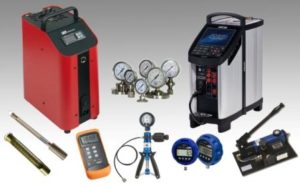Measuring Devices
There are some general purpose measuring devices such as fillet and radius gauge, screw pitch gauge, surface plate and try square which are described as under.
1. Fillet and Radius Gauge
Fig. shows the fillet and radius gauge, which is similar in construction to a screw pitch gauge and carries a similar metal case containing a number of steel blades in it. One set of blades, mounted on one end of the case carries concave end faces and the other set at the other end of the case, carries blades, which have convex end formations. The radii of the curvatures of the end formations are of different dimensions and thus provide a fairly wide range for quick checking and measuring of curvature. This instrument is highly useful for measuring and checking the inside and outside radii of fillets and other round surfaces. The fillet and radius gauges are made in thin strong strips curved to different radii at end. The use of this gauge is depicted through Fig.
2. Screw Pitch Gauge
Fig. shows the screw pitch gauge, which is a highly fool-proof, very effective and fairly accurate instrument used to identify or check the pitch of the threads cut on different threaded items. It consists of a case made of metal carrying a large number of blades or threaded strips which have teeth of different pitches, cut on their edges and markings corresponding to these pitches on their surfaces. In operation, different blades are applied or tried on the threads one after the other and when any one of them is found meshing with the cut teeth, the relevant reading is read directly from the marking on the matching blade surface. This gauge can be commonly used to measure or check the pitches of both external and internal threads. The free ends of the screw pitch gauge blades are generally made narrow for enabling them to enter the hollow parts easily while checking the internal threads. In some instruments, the blades are made to have markings both for the pitches as well as a value equal to double the depth of the threads. The latter quantity helps in determining quickly the drill size to be used before tapping.
3. Surface Plate
Fig. shows the surface plate, which is a cast iron plate having generally a square top well planed and square with adjacent machined faces. The top surface of the plate is finished true by means of grinding and scrapping. It possesses a cast iron base, which is also machined true to keep the top surface of the plate in a perfect horizontal plane. Its specific use is in testing the trueness of a finished surface, testing a try square, providing adequate bearing surface for V-block (Fig.) and angle plates, etc. in scribing work.
4. Try Square
Fig. shows the try square, which is also known as engineer’s try square. It is very important tool required for scribing straight lines at right angles to a true surface or testing the trueness of mutually normal surfaces. It is made in different sizes out of steel pieces. In construction, it is similar to a carpenter’s try square but is comparatively more accurate. It can be made either in one piece or in two pieces.
It consists of a steel blade fitted into a steel stock of rectangular cross-section. It is sufficiently hardened and tempered to suit the need. Some precision kind of try squares is made with their blades having beveled edges properly ground and finished square. Both inner and outer surface of the blade are kept truly at right angles to the corresponding surfaces of the stock. In order to maintain this trueness, this tool should be handled with due care and should never be used as a striking or supporting tool or other work. The accuracy of this tool should be frequently checked to ensure the trueness as it affects the accuracy of the finished job to a significant extent. For checking the accuracy or trueness of a try square, the try square is made to lie flat on the top surface of a surface plate with the stock touching a machined edge of the plate. A straight line is marked along the outer edge of the blade and then the square turned over to take a new position. Another straight line is described along the outer edge of the blade in this new position of the try square. If both lines coincide with each other as they seems to be as one line only, then the try square can be said as true. Source A Textbook of Basic Manufacturing Processes and Workshop Technology by Rajender Singh.













Post Comment
You must be logged in to post a comment.